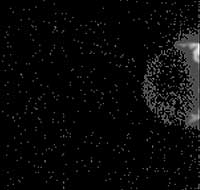|
COMETS EARTH JUPITER KUIPER BELT MARS MERCURY METEORITES NEPTUNE OORT CLOUD PLUTO SATURN SOLAR SYSTEM SPACE SUN URANUS VENUS ORDER PRINTS
PHOTO CATEGORIES SCIENCEVIEWS AMERICAN INDIAN AMPHIBIANS BIRDS BUGS FINE ART FOSSILS THE ISLANDS HISTORICAL PHOTOS MAMMALS OTHER PARKS PLANTS RELIGIOUS REPTILES SCIENCEVIEWS PRINTS
|
Related Document
Download Options
Within seconds of its closest approach to the asteroid 243 Ida on August 28, 1993, the Galileo spacecraft's Solid State Imaging camera caught this glimpse of Ida's previously unknown moon orbiting the asteroid. One frame of a 15-image set designed to capture a view of Ida at the highest possible resolution landed by chance with its edge right on the little moon. The range from the spacecraft was about 2,400 kilometers (1,500 miles), and each picture element spans about 24 meters (80 feet) on the surface of the moon. Only a small sliver of the sunlit crescent is visible at the edge of the frame (which was shifted inward toward the center in this representation). Ida itself is outside this frame to the left and slightly below center, roughly 90 kilometers (56 miles) away. The dark side of this moon is illuminated by light reflected from the sunlit side of Ida, in the same way that Earthshine brightens the dark part of Earth's Moon when it shows only a thin sunlit crescent, near 'new Moon'. The smoothly curving shape of the dark edge of Ida's moon can be seen on the left. The moon's observed dark side was just barely detectable by Galileo's camera; computer enhancement has made it easier to see in this picture. The visibility of the moon's dark limb has provided valuable information on the size and shape of the tiny moon, which measures about 1.2 x 1.4 x1.6 kilometers (0.75 x 0.87 x 1 mile). The little moon's relatively smooth egg shape contrasts markedly with the highly irregular shape of its parent, the asteroid Ida. This image was relayed to Earth from the Galileo spacecraft on June 8, 1994. The Galileo project, whose primary mission is the exploration of the Jupiter system in 1995-97, is managed for NASA's office of Space Science by the Jet Propulsion Laboratory. |
